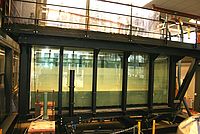Static Liquefaction Tank (SLT)
General Information
Instrument:
Fluidisation and inclinable liquefaction tank
Description:
The experimental set-up consists of a liquefaction tank with dimensions of 5 m (length), 2 m (width) and 2 m (height). The side-walls are made up of strong transparent hardened glass to allow visual observation and reduce lateral friction, while the end-walls and floor are made up of steel. The tank is supported on vibration-isolating systems to avoid external vibrations affecting the (loose) soil model in the tank.
Facilities:
Water-submerged layer of fine sand will be fluidised by up-flowing water. After sedimentation of the sand a rather homogeneous very loose sand structure will be obtained. For creating a submerged slope of loose fine sand, a part of this loose sand layer will be dredged away by applying a dredging technique. The instability can be induced either by excitation at the crest of the slope using a shallow foundation or by gradual tilting of slope.
Tilting of the tank is animated in the following video created by Clemens Krapfenbauer [M.Sc. student of our research group from Swiss Federal Institute of Technology in Zurich (ETHZ)]:
Static Liquefaction Tank (TU Delft)

Instrumentation:
The experimental set-up includes various types of sensors and actuators, which are all connected to the total data acquisition and control system. The data from all sensors can be logged at a frequency of 1 kHz upon triggering.
List of sensors in the liquefaction tank
Pore pressure transducers at the bottom of the tank
Pore pressure transducers at the wall of the tank
Pore pressure transducers at the wall of the tank
Total pressure sensors
Differential pressure transducers between the fluidisation tubes and the base of the sand layer
Load cells
Inclinometer
Encoder of the motor
Accelerometer
Temperature sensor
Pore pressure transducer for the supply pipe of the fluidisation system
Flow meter for the supply pipe of the fluidisation system
Level detector
Floating sensor: Pore pressure transducer, accelerometer
Location:
Laboratory of Geoscience and Engineering, Faculty of Civil Engineering and Geosciences, Stevinweg 1, Delft (Building #23).
Key Words:
Submarine landslides, flood defence systems, flow-slides, static liquefaction, dredging, physical modelling in geotechnics.
Main Application:
Offshore geotechnical engineering: submarine landslides and flowslides
Dredging in sand layers
Dikes and embankments
Soil structure interaction: shallow foundations
General slope stability analysis
Unsaturated soil mechanics
Soil vegetation interaction
Dynamic effects on geotechnical structures
List of internal reports on liquefaction
Presentation on liquefaction flow slides: Why, What, How, Frans Molenkamp, 23-11-2015.
Text announcement transfer lecture, Frans Molenkamp, 20-10-2015.
Determination of global sand density in liquefaction tank, Frans Molenkamp, Richard de Jager, 2-8-2015.
Stationary fluidized saturated column, Frans Molenkamp, Richard de Jager, 8-8-2015.
Overview of previous and remaining work by DEMO on instrumentation, data-acquisition and control for liquefaction tank, Frans Molenkamp, 13-7-2015.
Instrumentation and control of experiments in liquefaction tank, Rein van den Oever, Jan Graafland, Richard de Jager and Frans Molenkamp, 24-01-2013, provisionally extended FM, 27-01-2014 & 29-06-2015.
Superposed modes of deformation and flow in saturated heterogeneous Geomechanics. Transient hydrostatics and relative motion of pore fluid. Richard de Jager and Frans Molenkamp, 25-06-2015.
Ordering instrumentation for triaxial equipment enabling fluidization, Frans Molenkamp, 05-04-2015.
Characteristics of sensors and control of triaxial equipment for saturated sand samples prepared by fluidization, Richard de Jager, Frans Molenkamp, 11-3-2015.
Preparatory study of protocol and equipment for undrained triaxial testing of saturated sand samples prepared by fluidization, Richard de Jager and Frans Molenkamp, 8-3-2015.
Review of intergranular stress measure based on micro-macro approach, Richard de Jager and Frans Molenkamp, 20-01-2014.
Tilting of liquefaction tank and corresponding movements of spindles and couple axis, Richard de Jager and Frans Molenkamp, 11-11-2013.
Thermo-hydro-mechanical framework of saturated geomaterials, Frans Molenkamp and Richard de Jager, 30-08-2013.
Transient heterogeneous hydrostatics and viscous pore fluid flow, Frans Molenkamp, Richard de Jager, 10-12-2012.
Thermo-hydro-mechanical framework of heterogeneous unsaturated geomaterials, Frans Molenkamp, 05-07-2012.
Design of fluidization system for liquefaction tank, Frans Molenkamp, Richard de Jager, v2, 02-12-2014.
Considerations on requirements of hollow cylinder torsional shear testing of water-saturated loose fine sands for research programme on static liquefaction and subsequent flow, Richard de Jager, Frans Molenkamp, 15-03-2011.
Interactions between saturated soil phases involving linear momentum, Frans Molenkamp, 31-10-2009.
Mohr-Coulomb model, Frans Molenkamp, 12-06-2005.
Reference:
Tesegaye, A.B. (2009), “Evaluation of material models for modeling static liquefaction”, MSc thesis, Delft University of Technology.
Braakenburg, L.C.H. (2011), “Modelling static liquefaction with the simplified version of MONOT”, MSc thesis, Delft University of Technology.
Tesegaye, A.B., Molenkamp, F., Brinkgreve, R.B.J., Bonnier, P.G., De Jager, R.R., Galavi, V. (2010a), “Modelling liquefaction behaviour of sands by means of hypoplastic model”, In T. Benz & S. Nordal (Eds.), Numerical methods in Geotechnical Engineering: NUMGE 2010, pp 81-88.
Tesegaye, A.B., Galavi, V., Brinkgreve, R.B.J., De Jager, R.R., Molenkamp, F., Bonnier, P. (2010b), “Modeling static liquefaction with multilaminate framework”, In T. Benz & S. Nordal (Eds.), Numerical methods in Geotechnical Engineering: NUMGE 2010, pp 95-100.
de Jager, R.R., Braakenburg, L.C.H., Hicks, M.A., Molenkamp, F. (2011), “Towards modeling of static liquefaction of saturated loose sand”, In S Pietruszczak & GN Pande (Eds.), Computational Geomechanics Comgeo II, pp. 1-13.
de Jager, R.R., Molenkamp, F. (2012), “Fluidization system for liquefaction tank”, Proceedings of Eurofuge, Delft University of Technology and deltares, doi:10.4233/uuid:47ce6506-b678-46ee be42-414cc1a00d69.
de Jager, R.R., Mathijssen, F.A.J.M., Molenkamp, F. (2013), “Hydrostatics and relative motion of pore fluids”, Proceedings of COMGEO III, Krakow, 359-370.
Molenkamp, F., de Jager, R.R., Mathijssen, F.A.J.M. (2014), “Stress measures affecting deformation of granular materials”, Vadose Zone Journal, Vol. 13, Nr. 5, 17 pages, doi:10.2136/vzj2013.07.0130.
de Jager, R.R., Molenkamp, F. (2014), “Stress measures for interparticle sliding and particle rolling”, Proceedings of NUMGE, Delft, 18-20 June, pp. 61-66.

M.A. (Miguel) Cabrera PhD MEng
- +31 15 27 83663
- M.A.Cabrera@tudelft.nl
-
Room 00.500
Personal Page
Staff Page